Analyzing the Biological and Structural Diversity of Hyrcanian Forests Dominated by Taxus baccata L.
Abstract
1. Introduction
2. Materials and Methods
2.1. Study Areas
2.2. Biological Diversity
2.2.1. Measuring Tree Species Richness
2.2.2. The Species Abundance Distribution
2.3. Structural Diversity
3. Results
3.1. Species Richness per Hectare
3.2. The Species Abundance Distribution
3.3. Species Table
3.4. Relationships between Species-Specific Variables
3.5. Uniform Angle Index
4. Discussion
4.1. Measuring Species Richness
4.2. Edge-Corrected Neighborhood Groups
4.3. Measuring Tree Species Diversity
4.4. The Species Abundance Distribution
4.5. The Uniform Angle Index
5. Conclusions
Author Contributions
Funding
Conflicts of Interest
References
- Franklin, J.; Spies, T.; Van Pelt, R.; Carey, A.; Thornburgh, D.; Berg, D. Disturbances and structural development of natural forest ecosystems with silvicultural implications, using Douglas-fir forests as an example. For. Ecol. Manag. 2002, 155, 399–423. [Google Scholar] [CrossRef]
- Oliver, C.D.; Larson, B.C. Forest Stand Dynamics; Wiley: New York, NY, USA, 1996; ISBN 0471138339. [Google Scholar]
- Chen, H.Y.H.; Popadiouk, R.V. Dynamics of North American boreal mixedwoods. Environ. Rev. 2002, 10, 137–166. [Google Scholar] [CrossRef]
- Kint, V. Structural development in ageing temperate Scots pine stands. For. Ecol. Manag. 2005, 214, 237–250. [Google Scholar] [CrossRef]
- Gadow, K.; Zhang, C.; Wehenkel, C.; Pommerening, A.; Corral-Rivas, J.; Korol, M.; Pukkala, T.; Gadow, K. Forest structure and diversity. In Continuous Cover Forestry; Springer: Dordrecht, The Netherlands, 2012. [Google Scholar]
- Dhar, A.; Ruprecht, H.; Vacik, H. Population viability risk management (PVRM) for in situ management of endangered tree species-A case study on a Taxus baccata L. population. For. Ecol. Manag. 2008, 255, 2835–2845. [Google Scholar] [CrossRef]
- Ahmadi, K.; Jalil Alavi, S.; Zahedi Amiri, G.; Mohsen Hosseini, S.; Serra-Diaz, J.M.; Svenning, J. Patterns of density and structure of natural populations of Taxus baccata in the Hyrcanian forests of Iran. Nord. J. Bot. 2020, 38, 1–10. [Google Scholar] [CrossRef]
- Alijani, V.; Feghhi, J.; Zobeiri, M.; Marvi Mohadjer, M.R. Investigation of Different Forest Type’s Structure with Applying Nearest Neighbor Indices (Case Study: Gorazon District, Kheyrud Forest). Iran. J. Appl. Ecol. 2013, 2, 13–24. [Google Scholar]
- Wiegand, T.; Moloney, K. Rings, circles, and null-models for point pattern analysis in ecology. Oikos 2004, 104, 209–229. [Google Scholar] [CrossRef]
- Lexerød, N.L.N.; Eid, T. An evaluation of different diameter diversity indices based on criteria related to forest management planning. For. Ecol. Manag. 2006, 222, 17–28. [Google Scholar] [CrossRef]
- Getzin, S.; Dean, C.; He, F.; Trofymow, J.; Wiegand, K.; Wiegand, T.; Trofymow, J.A.; Wiegand, K.; Wiegand, T. Spatial patterns and competition of tree species in a Douglas-fir chronosequence on Vancouver Island. Ecography 2006, 29, 671–682. [Google Scholar] [CrossRef]
- Corral-Rivas, J.J.; Wehenkel, C.; Castellanos-Bocaz, H.A.; Vargas-Larreta, B.; Diéguez-Aranda, U. A permutation test of spatial randomness: Application to nearest neighbour indices in forest stands. J. For. Res. 2010, 15, 218–225. [Google Scholar] [CrossRef]
- von Gadow, K.; Füldner, K. Zur bestandesbeschreibung in der forsteinrichtung. Forst Holz 1993, 48, 602–606. [Google Scholar]
- Hui, G.Y.; Gadow, K.V. Quantitative Analysis of Forest Spatial Structure; China Science and Technology Press: Beijing China, 2003; pp. 16–18. [Google Scholar]
- Aguirre, O.; Hui, G.; von Gadow, K.; Jiménez, J. An analysis of spatial forest structure using neighbourhood-based variables. For. Ecol. Manag. 2003, 183, 137–145. [Google Scholar] [CrossRef]
- Von Gadow, K.; Hui, G.Y. Characterizing forest spatial structure and diversity. In Sustainable Forestry in Temperate Regions; Björk, L., Ed.; SUFOR, University of Lund: Lund, Sweden, 2002; pp. 20–30. [Google Scholar]
- Zohary, M. Geobotanical Foundations of the Middle East; Fischer: Quezon City, Philippines, 1973. [Google Scholar]
- Rechinger, K.H. Flora iranica. In Graz: Akademische Druck-und Verlasanstalt (1-174); Naturhistorisches Museum: Wien, Austria, 1963. [Google Scholar]
- Javanchir, K. Quelques observations sur les forêts de l’ouest de l’Iran. Class. Oxf. 1971, 182, 440–442. [Google Scholar]
- Akhani, H. Studies on the flora and vegetation of the Golestan National Park, NE Iran, I: A new species and some new plant records. Ann. des Naturhistorischen Museums Wien. Ser. B für Bot. Zool. 1996, 98B, 97–105. [Google Scholar]
- Hamzeh’ee, B.; Naqinezhad, A.; Attar, F.; Ghahreman, A.; Assadi, M.; Prieditis, N. Phytosociological survey of remnant Alnus glutinosa ssp. barbata communities in the lowland Caspian forests of northern Iran. Phytocoenologia 2008, 38, 117–132. [Google Scholar] [CrossRef]
- Khodadadi, S.; Saeidi Mehrvarz, S.; Naqinezhad, A. Contribution to the flora and habitats of the Estil wetland (Astara) and its surroundings, Northwest Iran. Rostaniha 2009, 10, 110–111. [Google Scholar]
- Akhani, H.; Djamali, M.; Ghorbanalizadeh, A.; Ramezani, E. Plant biodiversity of Hyrcanian relict forests, N Iran: An overview of the flora, vegetation, palaeoecology and conservation. Pak. J. Bot. 2010, 42, 231–258. [Google Scholar]
- Thomas, P.A.; Polwart, A. Biological Flora of the British Isles, no. 229. Taxus baccata L. J. Ecol. 2003, 91, 489–524. [Google Scholar] [CrossRef]
- Mossadegh, A. Taxus baccata forests, in Iran. J. Environ. Stud. 2002, 27, 73–84. [Google Scholar]
- Foa, R.; Norton, L.; Seidman, A.D. Taxol (paclitaxel): A novel anti-microtubule agent with remarkable anti-neoplastic activity. Int. J. Clin. Lab. Res. 1994, 24, 6–14. [Google Scholar] [CrossRef] [PubMed]
- Bryan, J.; Twelves, C. How bark from the Pacific yew tree improved the treatment of breast cancer. Pharm. J. 2011, 287, 369. [Google Scholar]
- Myking, T.; Vakkari, P.; Skrøppa, T. Genetic variation in northern marginal Taxus baccata L. populations. Implications for conservation. Forestry 2009, 82, 529–539. [Google Scholar] [CrossRef]
- Dobrowolska, D.; Niemczyk, M.; Olszowska, G. The influence of stand structure on European yew Taxus baccata populations in its natural habitats in central Poland. Polish J. Ecol. 2017, 65, 369–384. [Google Scholar] [CrossRef]
- Svenning, J.-C.; Magård, E. Population ecology and conservation status of the last natural population of English yew Taxus baccata in Denmark. Biol. Conserv. 1999, 88, 173–182. [Google Scholar] [CrossRef]
- Ghanbari, S.; Sefidi, K.; Fathizadeh, O. Composition and structure of English yew forest stands (Taxus baccata L.) in different conservation systems of Arasbaran forests, Iran. J. Wood For. Sci. Technol. 2019, 26, 31–49. [Google Scholar] [CrossRef]
- Waez-Mousavi, S.M.; MaghsoudlouNezhad, M. Yew (Taxusbaccata L.) population in Tuskaestan Valley, North of Iran. Der Eibenfreund 2011, 17, 147–151. [Google Scholar]
- Esmailzadeh, O.; Hosseini, S.M. A phytosociological study of English yew (Taxus baccata L.) in Afratakhteh reserve. Pajouhesh Sazandegi 2007, 20, 17–24. [Google Scholar]
- Habibi Kaseb, H.; Lesani, M.R. Investigating the soil conditions and quality of Taxus baccata forest stands in Iran. Iran. J. Nat. Resour. 1985, 39, 13–28. [Google Scholar]
- Zand Akbari, S. Taxol Measurement by TLC-DENSITOMETRY. Master’s Thesis, Tarbiat Moallem University, Tehran, Iran, 1999; 76p. (In Persian). [Google Scholar]
- Ahmadi, T.; Zarrin Kafsh, M.; Sardabi, H. Investigating the relationship between soil physical and chemical properties and its mineral nutrition by the yew tree in Vaz research forest (west of Mazandaran). Pashouhesh Sazandegi J. 2000, 13, 69–75. [Google Scholar]
- Mohajer Orsaji, N. Investigating the Most Important Effect of Environmental Characteristics on the Quantity and Quality of Taxus baccata Stands in Pouneh-Aram Siah-Roudbar Area of Aliabad. Master’s Thesis, Tarbiat Moallem University, Tehran, Iran, 2003; 76p. (In Persian). [Google Scholar]
- Ebady, A.; Omidvar, A. Relationship between some ecological factors and distribution of yew tree (Taxus baccuta L.) in Arasbaran forests (Case study: Ilganechay and Horand regions). Iran. J. For. Poplar Res. 2011, 19, 327–339. [Google Scholar] [CrossRef]
- Alemi, A.; Eslami, A.; Shataee Joibari, S. Investigation on development potential of endangered species of Taxus baccata at Golestan Province, based on GIS technology (Case study: Pooneh Aram reserve). Iran. J. For. Poplar Res. 2014, 21, 678–689. [Google Scholar] [CrossRef]
- Alavi, S.J.; Ahmadi, K.; Hosseini, S.M.; Tabari, M.; Nouri, Z. The response of English yew (Taxus baccata L.) to climate change in the Caspian Hyrcanian Mixed Forest ecoregion. Reg. Environ. Chang. 2019, 19, 1495–1506. [Google Scholar] [CrossRef]
- Alavi, J.; Ahmadi, K.; Hosseini, S.M.; Masoud, T.; Nouri, Z. The importance of climatic, topographic and edaphic variables in the distribution of yew species (Taxus baccata L.) and prioritization of areas for conservation and restoration in the north of Iran. Iran. J. For. 2020, 11, 477–492. [Google Scholar]
- Keren, S.; Svoboda, M.; Janda, P.; Nagel, T.A. Relationships between Structural Indices and Conventional Stand Attributes in an Old-Growth Forest in Southeast Europe. Forests 2020, 11, 4. [Google Scholar] [CrossRef]
- Williams, C.B. Patterns in the Balance of Nature and Related Problems of Quantitative Ecology; Academic Press: London, UK, 1964. [Google Scholar]
- Barkman, J.J. A critical evaluation of minimum area concepts. Vegetatio 1989, 85, 89–104. [Google Scholar] [CrossRef]
- Lawton, J.H. Are there general laws in ecology? Oikos 1999, 84, 177–192. [Google Scholar] [CrossRef]
- Matthews, T.J.; Whittaker, R.J. Fitting and comparing competing models of the species abundance distribution: Assessment and prospect. Front. Biogeogr. 2014, 6. [Google Scholar] [CrossRef]
- Komonen, A.; Elo, M. Ecological response hides behind the species abundance distribution: Community response to low-intensity disturbance in managed grasslands. Ecol. Evol. 2017, 7, 8558–8566. [Google Scholar] [CrossRef]
- Dunstan, P.K.; Bax, N.J.; Foster, S.D.; Williams, A.; Althaus, F. Identifying hotspots for biodiversity management using rank abundance distributions. Divers. Distrib. 2012, 18, 22–32. [Google Scholar] [CrossRef]
- Pommerening, A.; Wang, H.; Zhao, Z. Global woodland structure from local interactions: New nearest-neighbour functions for understanding the ontogenesis of global forest structure. For. Ecosyst. 2020, 7, 1–11. [Google Scholar] [CrossRef]
- Pommerening, A.; Grabarnik, P. Individual-Based Methods in Forest Ecology and Management; Springer: Berlin, Germany, 2019; ISBN 3030245284. [Google Scholar]
- Hui, G.Y.; Albert, M.; Gadow, K.V. DasUmgebungsmaß als Parameter zur Nachbildung von Bestandesstrukturen. Forstwiss. Cent. Ver. Mit Tharandter Forstl. Jahrb. 1998, 117, 258–266. [Google Scholar] [CrossRef]
- von Gadow, K.; Hui, G.Y.; Albert, M. Das Winkelmass-ein Strukturparameter zur Beschreibung der Individualverteilung in Waldbestanden. Cent. Fur Das Ges. Forstw 1998, 115, 1–10. [Google Scholar]
- McGill, B.J.; Etienne, R.S.; Gray, J.S.; Alonso, D.; Anderson, M.J.; Benecha, H.K.; Dornelas, M.; Enquist, B.J.; Green, J.L.; He, F. Species abundance distributions: Moving beyond single prediction theories to integration within an ecological framework. Ecol. Lett. 2007, 10, 995–1015. [Google Scholar] [CrossRef] [PubMed]
- McGlinn, D.J.; Xiao, X.; May, F.; Gotelli, N.J.; Engel, T.; Blowes, S.A.; Knight, T.M.; Purschke, O.; Chase, J.M.; McGill, B.J. Measurement of Biodiversity (MoB): A method to separate the scale-dependent effects of species abundance distribution, density, and aggregation on diversity change. Methods Ecol. Evol. 2019, 10, 258–269. [Google Scholar] [CrossRef]
- Preston, F.W. The canonical distribution of commonness and rarity: Part I. Ecology 1962, 43, 185–215. [Google Scholar] [CrossRef]
- May, R.M. Patterns of species abundance and diversity. Ecol. Evol. Communities 1975, 81–120. [Google Scholar]
- Hubbell, S.P. The Unified Neutral Theory of Biodiversity and Biogeography (MPB-32); Princeton University Press: Princeton, NJ, USA, 2001; ISBN 0691021287. [Google Scholar]
- von Gadow, K.; Hui, G.Y. Can the tree species-area relationship be derived from prior knowledge of the tree species richness. Stud 2007, 46, 13–22. [Google Scholar]
- Spellerberg, I.F.; Fedor, P.J. A tribute to Claude Shannon (1916–2001) and a plea for more rigorous use of species richness, species diversity and the ‘Shannon–Wiener’Index. Glob. Ecol. Biogeogr. 2003, 12, 177–179. [Google Scholar] [CrossRef]
- Kumar, A.R.V. Avalanclne index: A new measure of biodiversity based on biological heterogeneity of the communities. Curr. Sci. 1997, 73, 128–132. [Google Scholar]
- Hao, M.; Corral-Rivas, J.J.; González-Elizondo, M.S.; Ganeshaiah, K.N.; Nava-Miranda, M.G.; Zhang, C.; Zhao, X.; Von Gadow, K. Assessing biological dissimilarities between five forest communities. For. Ecosyst. 2019, 6, 1–8. [Google Scholar] [CrossRef]
- Tallents, L.A.; Lovett, J.C.; Hall, J.B.; Hamilton, A.C. Phylogenetic diversity of forest trees in the Usambara mountains of Tanzania: Correlations with altitude. Bot. J. Linn. Soc. 2005, 149, 217–228. [Google Scholar] [CrossRef]
- Kint, V.; Lust, N.; Ferris, R.; Olsthoorn, A.F.M. Quantification of forest stand structure applied to Scots pine (Pinus sylvestris L.) forests. For. Syst. 2000, 9, 147–163. [Google Scholar]
- Hesabi, A.; Alavi, S.J.; Esmailzadeh, O. Studying the interaction between English yew (Taxus baccata L.) adult trees and its regeneration in Afratakhteh Forest Reserve, Golestan province. Iran. J. For. 2019, 11, 165–177. [Google Scholar]
- Forget, P.-M.; Mercier, F.; Collinet, F. Spatial patterns of two rodent-dispersed rain forest trees Carapa procera (Meliaceae) and Vouacapoua americana (Caesalpiniaceae) at Paracou, French Guiana. J. Trop. Ecol. 1999, 15, 301–313. [Google Scholar] [CrossRef]
- Jafari Afrapoly, M.; Sefidi, K.; Varamesh, S.; Waez-Mousavi, S.M. Structural Characteristic of English Yew (Taxus baccata L.) Stands in the Afratakhteh Forests Reserveeserve. Iran. J. Appl. Ecol. 2019, 7, 11–19. [Google Scholar]
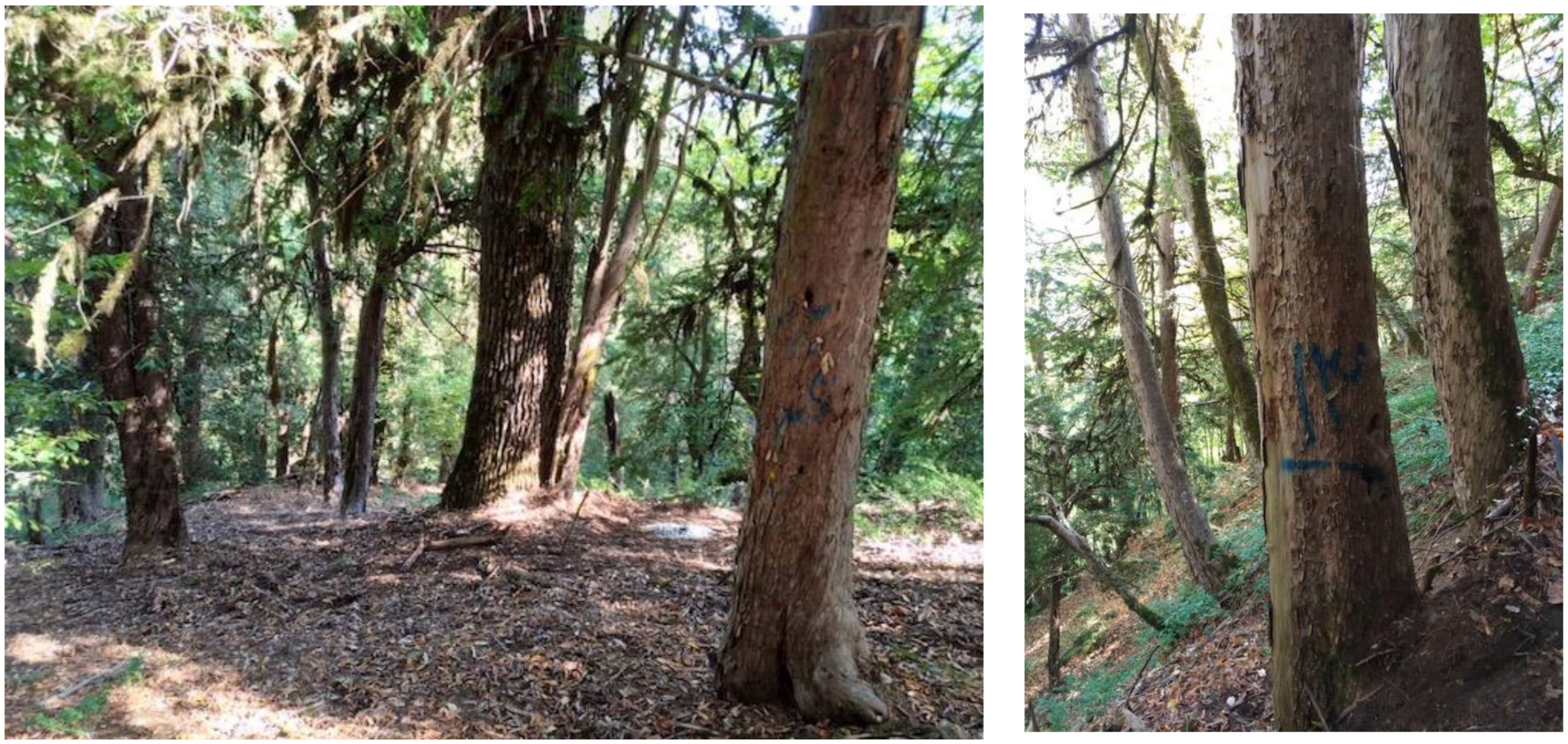
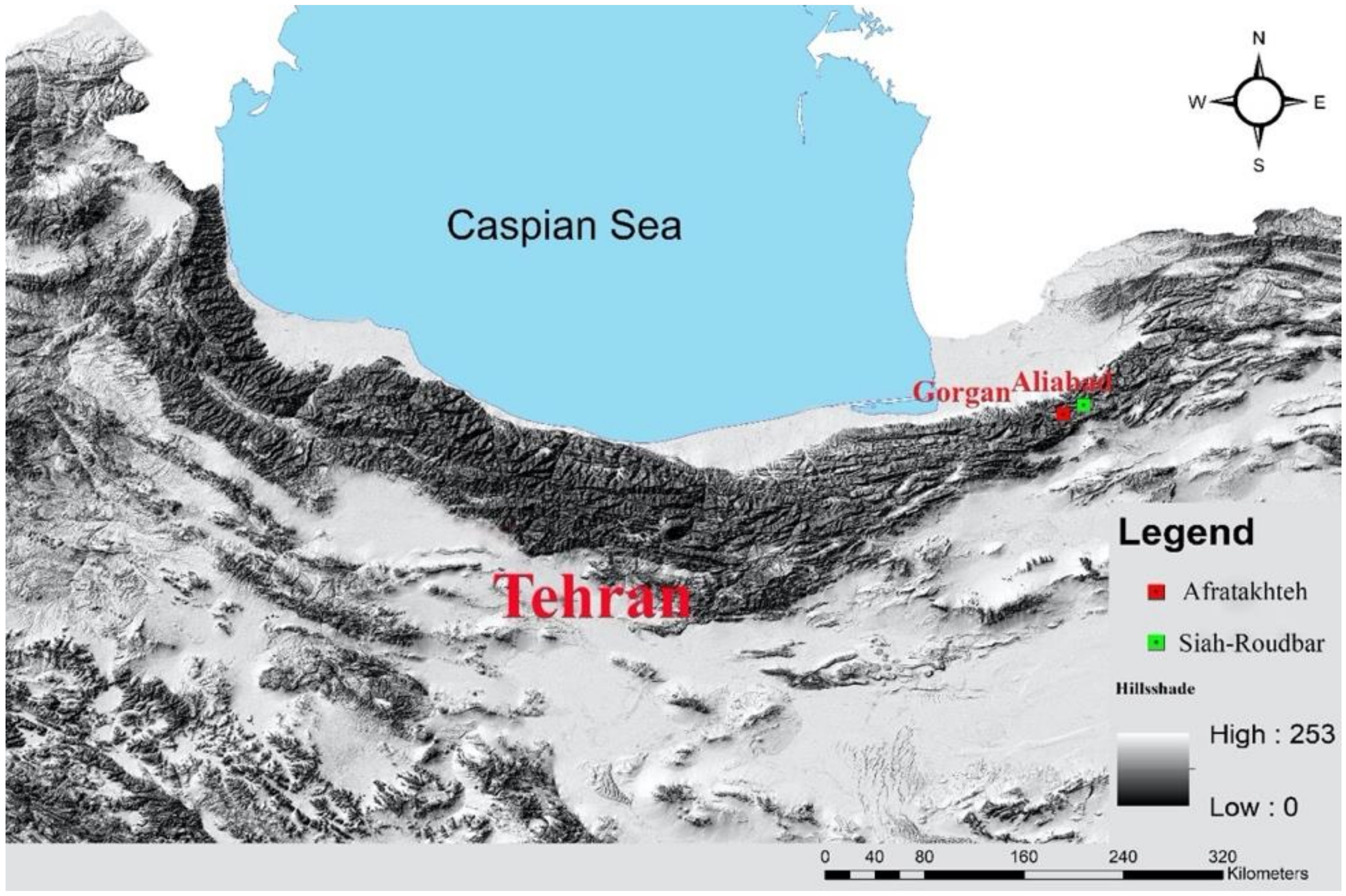
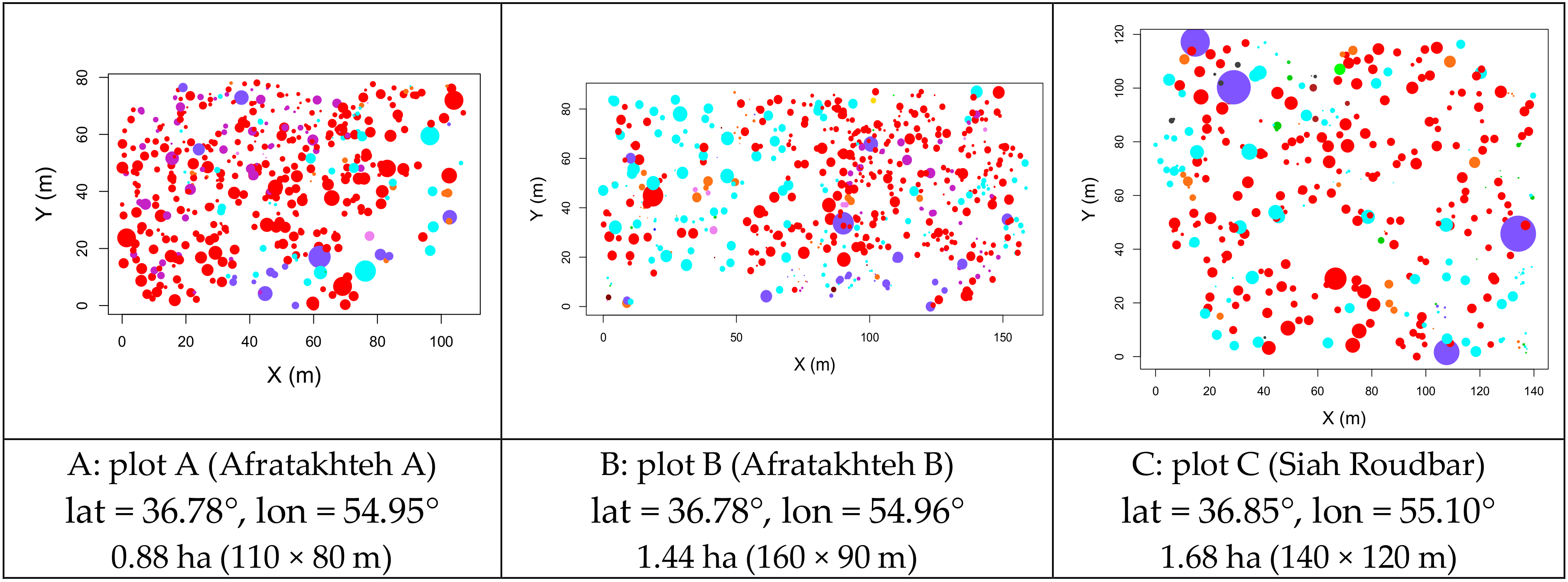
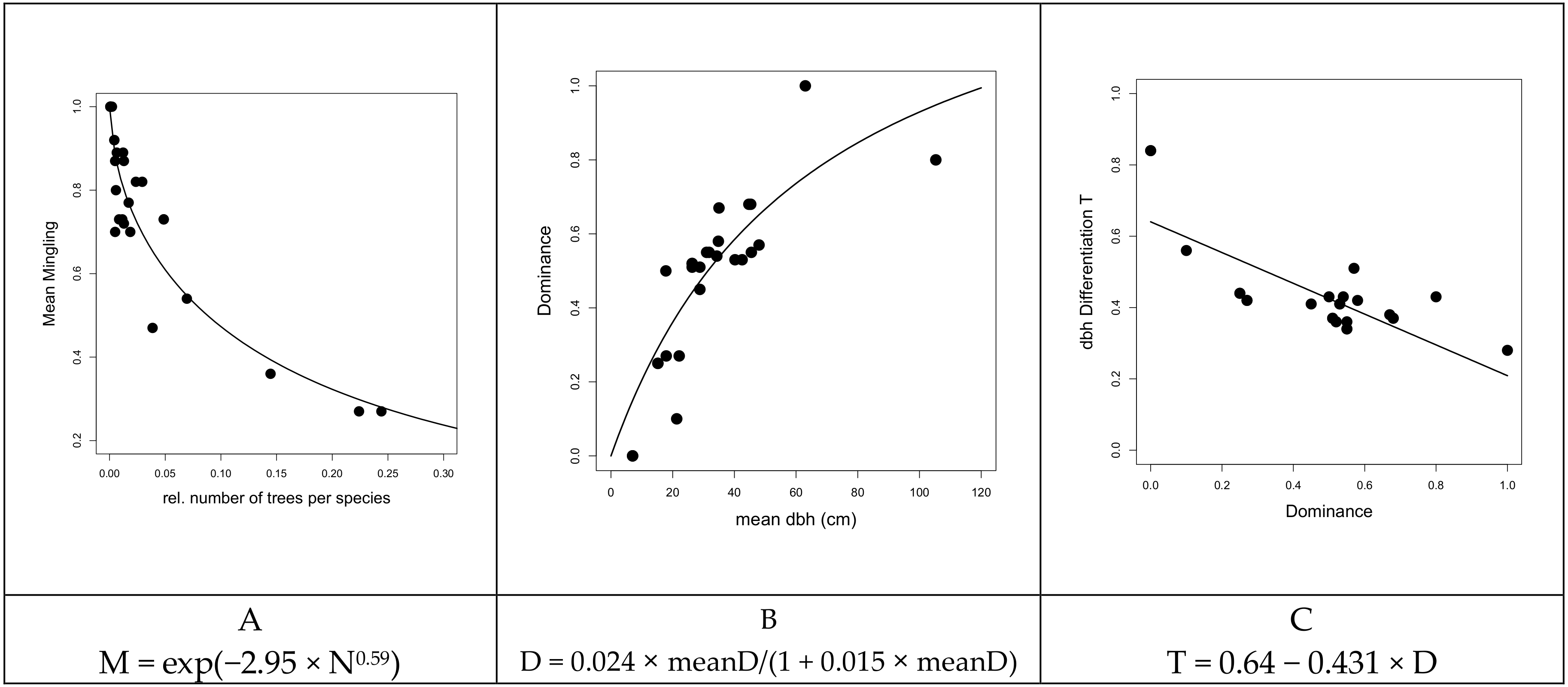
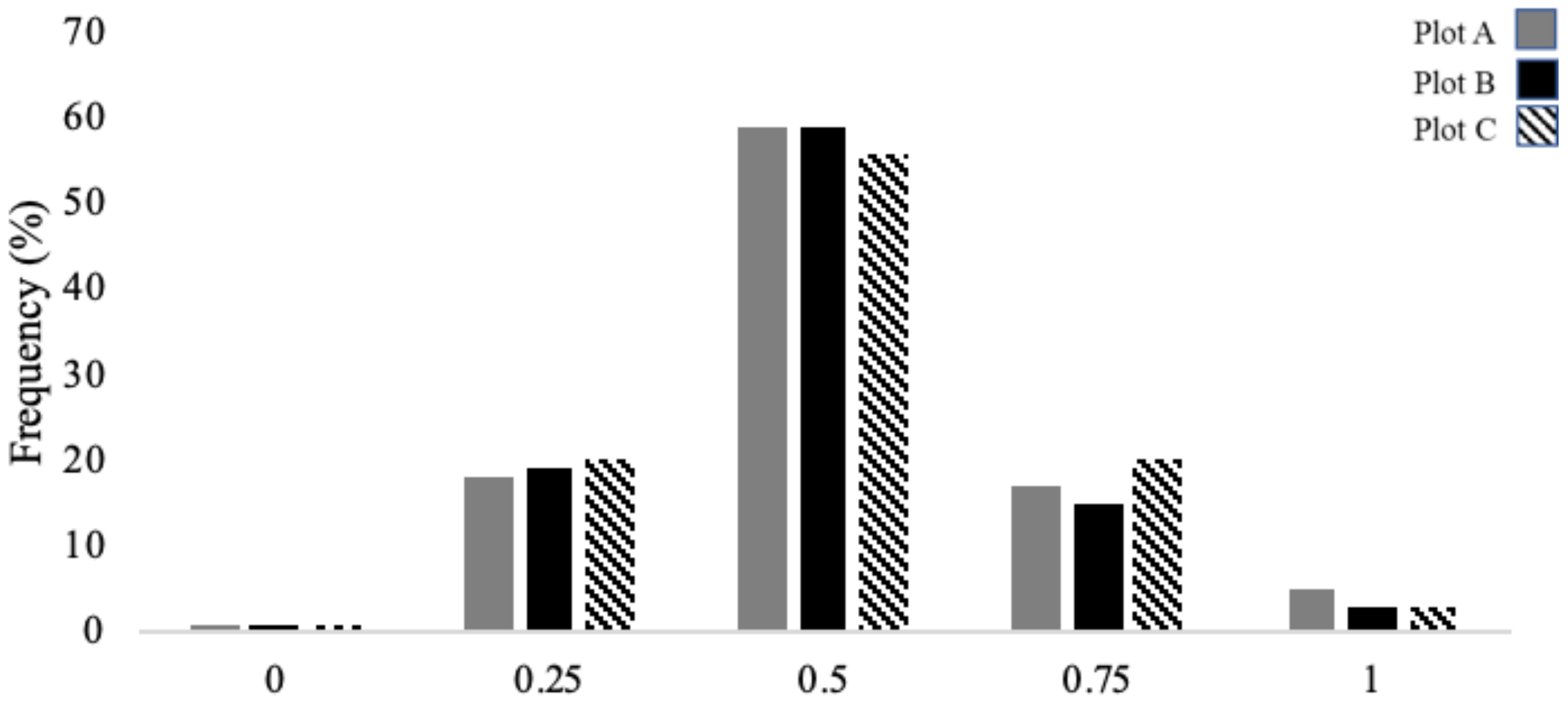
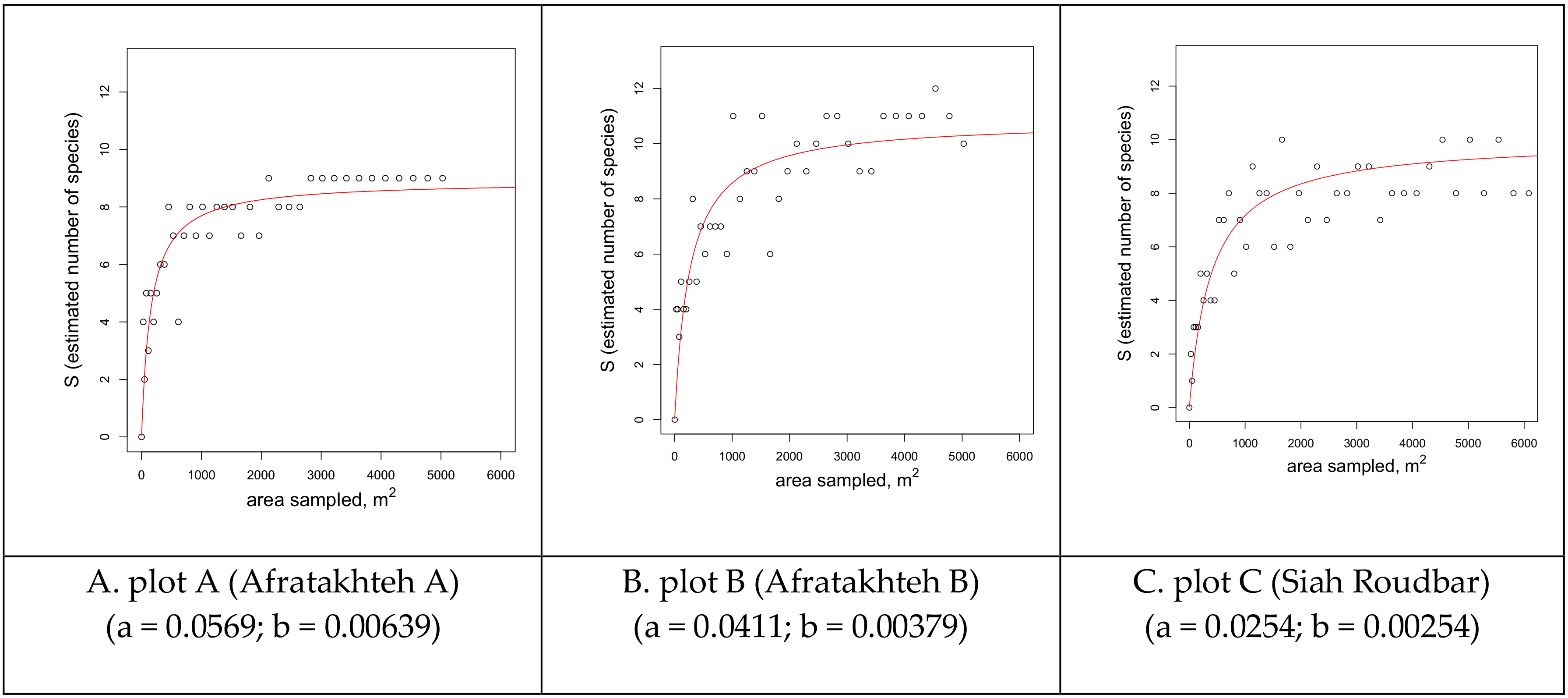
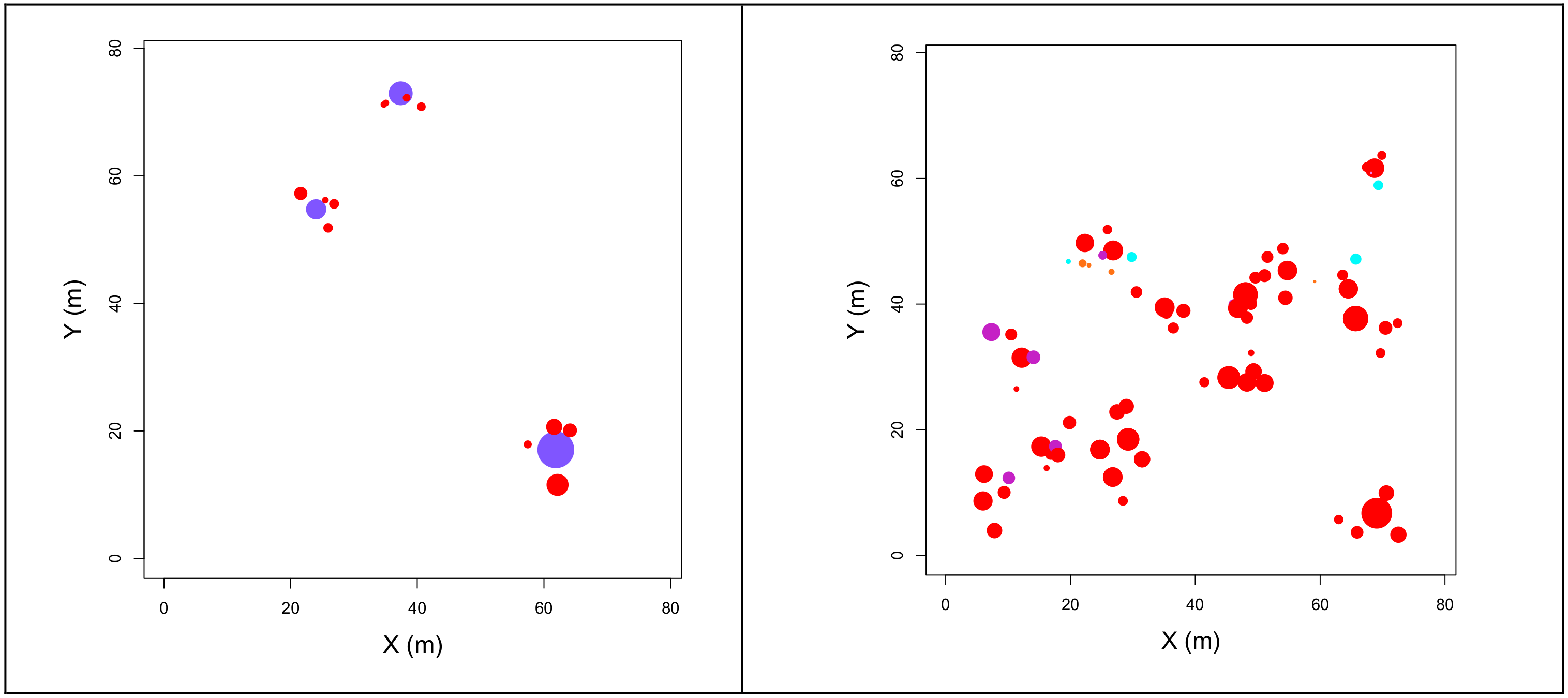
| Mingling (M) | Dominance (D) | Size Differentiation (T) |
|---|---|---|
| Mean heterospecific fraction of trees among the k nearest neighbors of a given tree i. | Mean fraction of n nearest neighbors with a dbh < (dbh of the reference tree). | Mean of the ratio of smaller and larger tree sizes u of the k nearest neighbors subtracted from one. |
| Plot | a | b | Observed Number of Species per ha | Maximum Number of Species (a/b) |
|---|---|---|---|---|
| A | 0.0569 | 0.00639 | 8 | 8.9 |
| B | 0.0411 | 0.00379 | 8 | 10.8 |
| C | 0.0254 | 0.00254 | 10 | 10.0 |
| Number | Species | Freqency | |
|---|---|---|---|
| 1 | Taxus baccata | 874 | 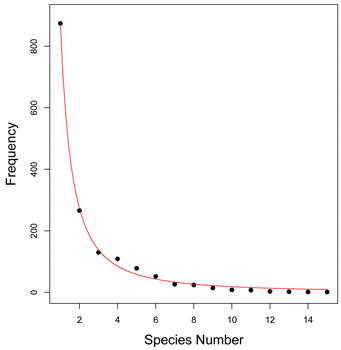 |
| 2 | Carpinus betulus | 266 | |
| 3 | Tilia rubra | 130 | |
| 4 | Carpinus schuschaensis | 109 | |
| 5 | Acer laetum | 78 | |
| 6 | Quercus castaneifolia | 52 | |
| 7 | Acer velutinum | 26 | |
| 8 | Ulmus glabra | 24 | |
| 9 | Sorbus torminalis | 14 | |
| 10 | Parrotia persica | 8 | |
| 11 | Cerasus avium | 7 | |
| 12 | Prunus avium | 3 | |
| 13 | Fraxinus excelsior | 2 | |
| 14 | Alnus subcordata | 1 | |
| 15 | Cornus australis | 1 |
| Plot | Species | Family | Mean dbh | Trees per ha | BA m2/ha | M | D | T |
|---|---|---|---|---|---|---|---|---|
| A | Acer laetum | Sapindaceae | 17.9 | 9 | 0.16 | 0.89 | 0.27 | 0.42 |
| Carpinus betulus | Betulaceae | 26.3 | 33 | 1.65 | 0.82 | 0.51 | 0.37 | |
| Carpinus schuschaensis | Betulaceae | 26.3 | 68 | 2.83 | 0.73 | 0.52 | 0.38 | |
| Quercus castaneifolia | Fagaceae | 45.3 | 12 | 1.52 | 0.73 | 0.68 | 0.37 | |
| Sorbus torminalis | Rosaceae | 15.2 | 6 | 0.12 | 0.92 | 0.25 | 0.44 | |
| Taxus baccata | Taxaceae | 31.0 | 313 | 17.71 | 0.27 | 0.55 | 0.34 | |
| Tilia rubra | Malvaceae | 42.5 | 7 | 0.84 | 0.87 | 0.53 | 0.41 | |
| Ulmus glabra | Ulmaceae | 7 | 1 | 0 | 1.00 | 0.00 | 0.84 | |
| total | 449 | 24.83 | ||||||
| B | Acer laetum | Sapindaceae | 22.1 | 17 | 0.61 | 0.64 | 0.47 | 0.61 |
| Carpinus betulus | Betulaceae | 28.8 | 41 | 3.25 | 0.59 | 0.55 | 0.47 | |
| Carpinus schuschaensis | Betulaceae | 26.3 | 68 | 3.72 | 0.74 | 0.42 | 0.36 | |
| Quercus castaneifolia | Fagaceae | 44.7 | 16 | 2.58 | 0.65 | 0.60 | 0.46 | |
| Sorbus torminalis | Rosaceae | 15.2 | 6 | 0.16 | 0.89 | 0.46 | 0.35 | |
| Taxus baccata | Taxaceae | 31.8 | 341 | 26.89 | 0.33 | 0.56 | 0.38 | |
| Tilia rubra | Malvaceae | 40.2 | 18 | 2.46 | 0.76 | 0.54 | 0.41 | |
| Ulmus glabra | Ulmaceae | 7 | 1 | 0 | 1.00 | 0.12 | 0.59 | |
| total | 508 | 39.68 | ||||||
| C | Acer laetum | Sapindaceae | 28.8 | 26 | 1.48 | 0.70 | 0.43 | 0.51 |
| Acer velutinum | Sapindaceae | 34.8 | 24 | 2.39 | 0.74 | 0.54 | 0.44 | |
| Carpinus betulus | Betulaceae | 34.3 | 97 | 7.96 | 0.54 | 0.55 | 0.50 | |
| Fraxinus excelsior | Oleaceae | 63 | 1 | 0.19 | 1.00 | 1.00 | 0.29 | |
| Parrotia persica | Hamamelidaceae | 21.3 | 8 | 0.2 | 0.80 | 0.10 | 0.74 | |
| Prunus avium | Rosacea | 35 | 3 | 0.18 | 1.00 | 0.67 | 0.60 | |
| Quercus castaneifolia | Fagaceae | 105.3 | 7 | 5.9 | 0.70 | 0.80 | 0.48 | |
| Taxus baccata | Taxaceae | 45.5 | 202 | 22.26 | 0.36 | 0.55 | 0.45 | |
| Tilia rubra | Malvaceae | 48 | 54 | 9.25 | 0.47 | 0.57 | 0.58 | |
| Ulmus glabra | Ulmaceae | 17.8 | 18 | 0.37 | 0.72 | 0.50 | 0.61 | |
| total | 440 | 50.19 | ||||||
| Mean dbh | N | BA | M | D | T | |
|---|---|---|---|---|---|---|
| mean dbh | 1 | 0.02 | 0.22 | −0.22 | 0.76 | −0.25 |
| N | 0.02 | 1 | 0.94 | −0.81 | 0.14 | −0.15 |
| BA | 0.22 | 0.94 | 1 | −0.84 | 0.22 | −0.18 |
| M | −0.22 | −0.81 | −0.84 | 1 | −0.26 | 0.26 |
| D | 0.76 | 0.14 | 0.22 | −0.26 | 1 | −0.50 |
| T | −0.25 | −0.15 | −0.18 | 0.26 | −0.50 | 1 |
© 2020 by the authors. Licensee MDPI, Basel, Switzerland. This article is an open access article distributed under the terms and conditions of the Creative Commons Attribution (CC BY) license (http://creativecommons.org/licenses/by/4.0/).
Share and Cite
Alavi, S.J.; Veiskarami, R.; Esmailzadeh, O.; Gadow, K.v. Analyzing the Biological and Structural Diversity of Hyrcanian Forests Dominated by Taxus baccata L. Forests 2020, 11, 701. https://doi.org/10.3390/f11060701
Alavi SJ, Veiskarami R, Esmailzadeh O, Gadow Kv. Analyzing the Biological and Structural Diversity of Hyrcanian Forests Dominated by Taxus baccata L. Forests. 2020; 11(6):701. https://doi.org/10.3390/f11060701
Chicago/Turabian StyleAlavi, Seyed Jalil, Razieh Veiskarami, Omid Esmailzadeh, and Klaus v. Gadow. 2020. "Analyzing the Biological and Structural Diversity of Hyrcanian Forests Dominated by Taxus baccata L." Forests 11, no. 6: 701. https://doi.org/10.3390/f11060701
APA StyleAlavi, S. J., Veiskarami, R., Esmailzadeh, O., & Gadow, K. v. (2020). Analyzing the Biological and Structural Diversity of Hyrcanian Forests Dominated by Taxus baccata L. Forests, 11(6), 701. https://doi.org/10.3390/f11060701





